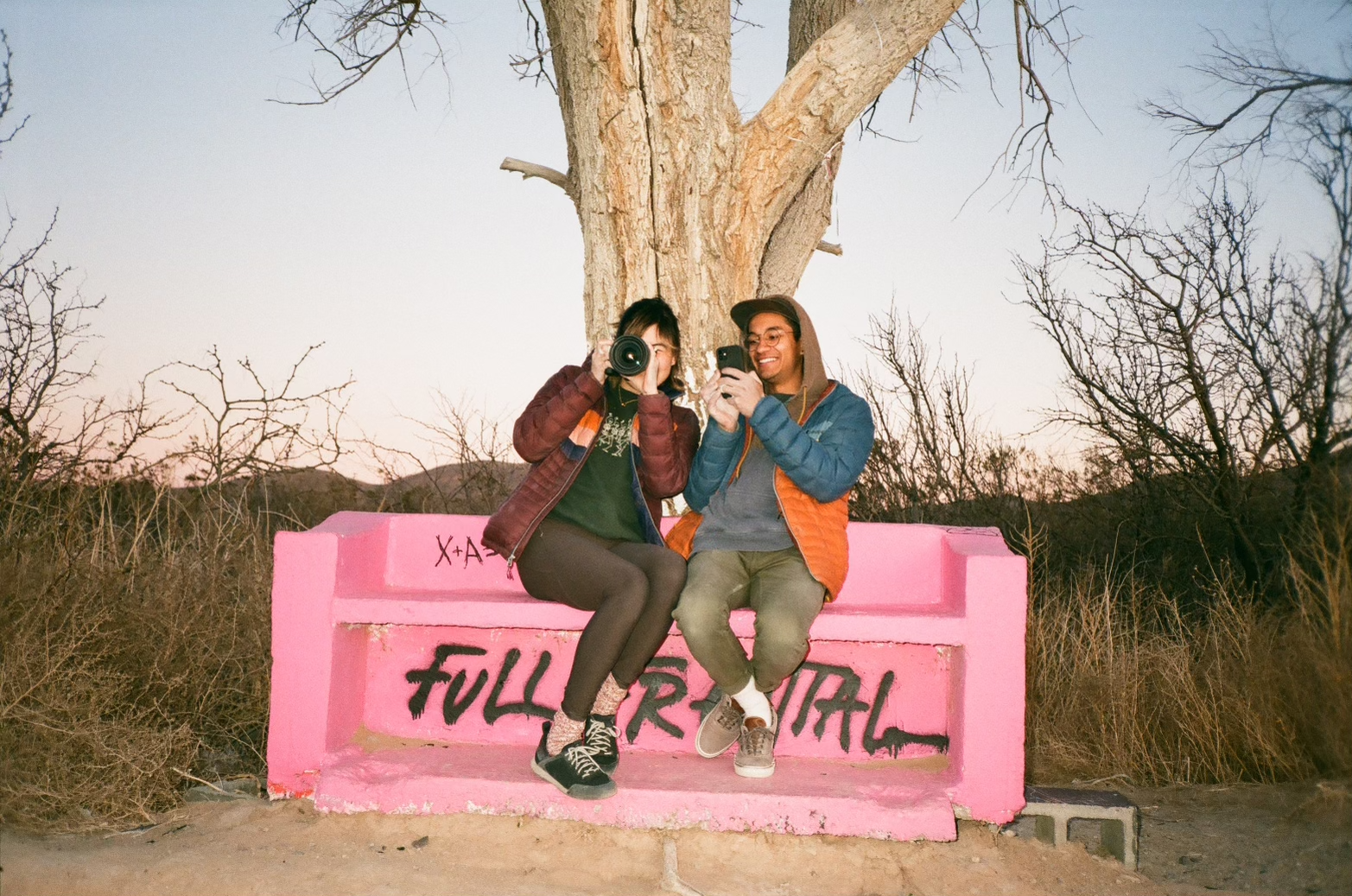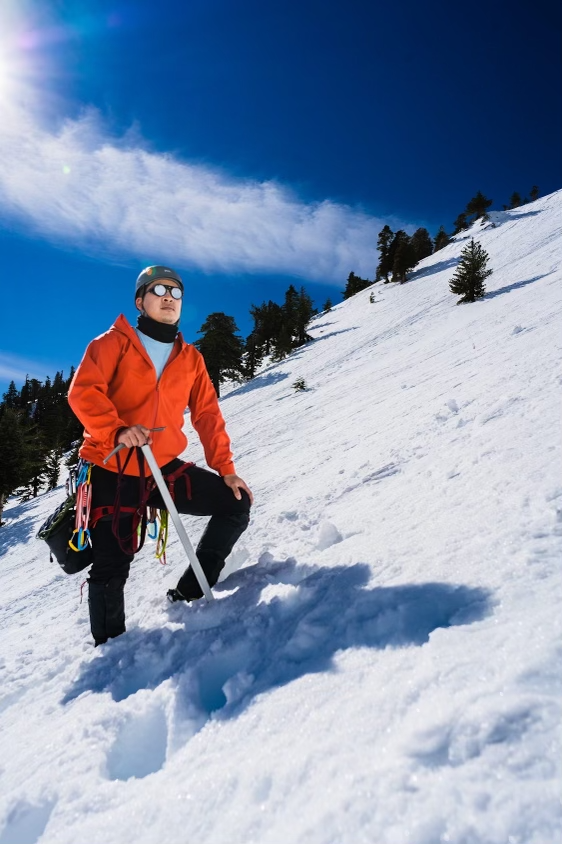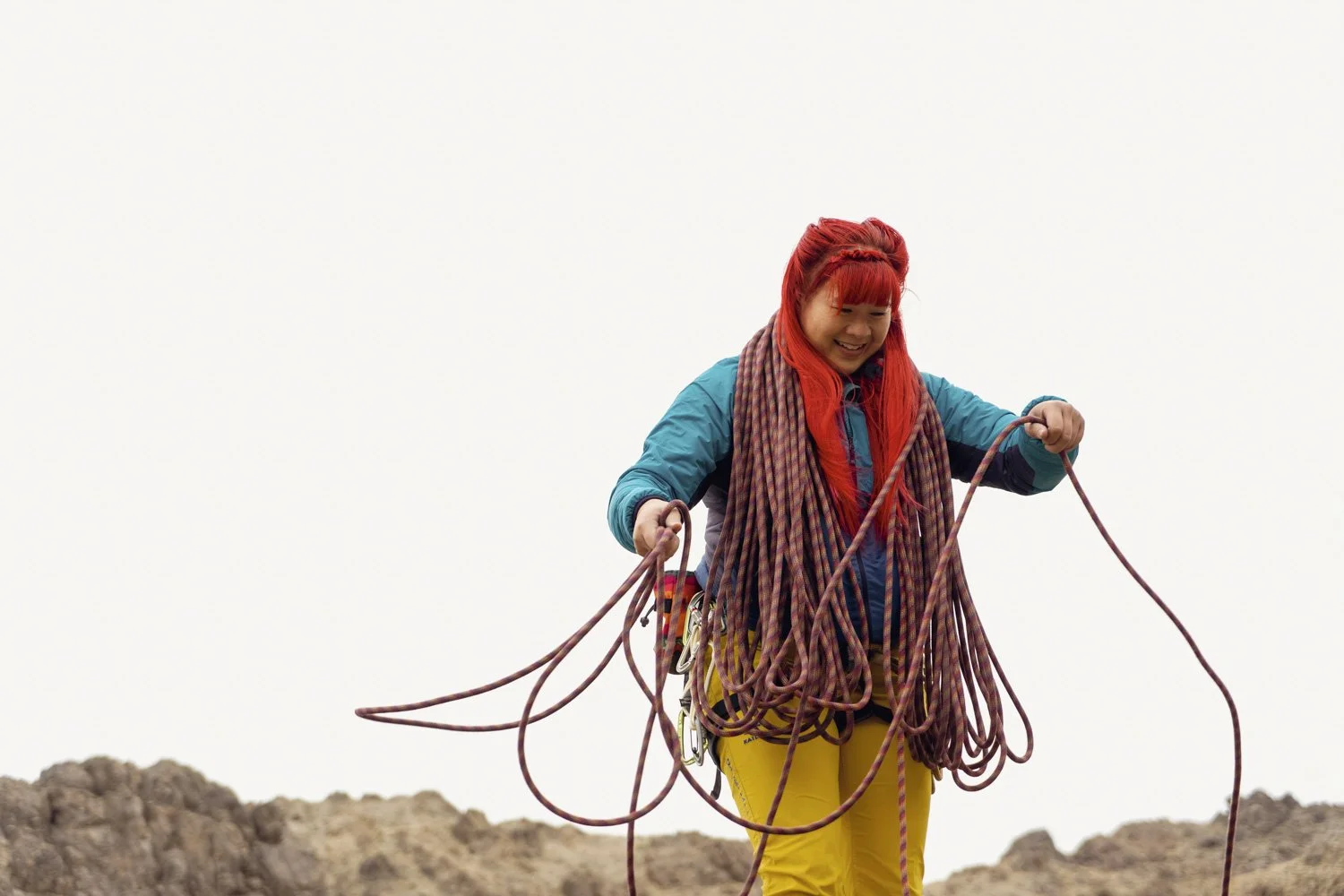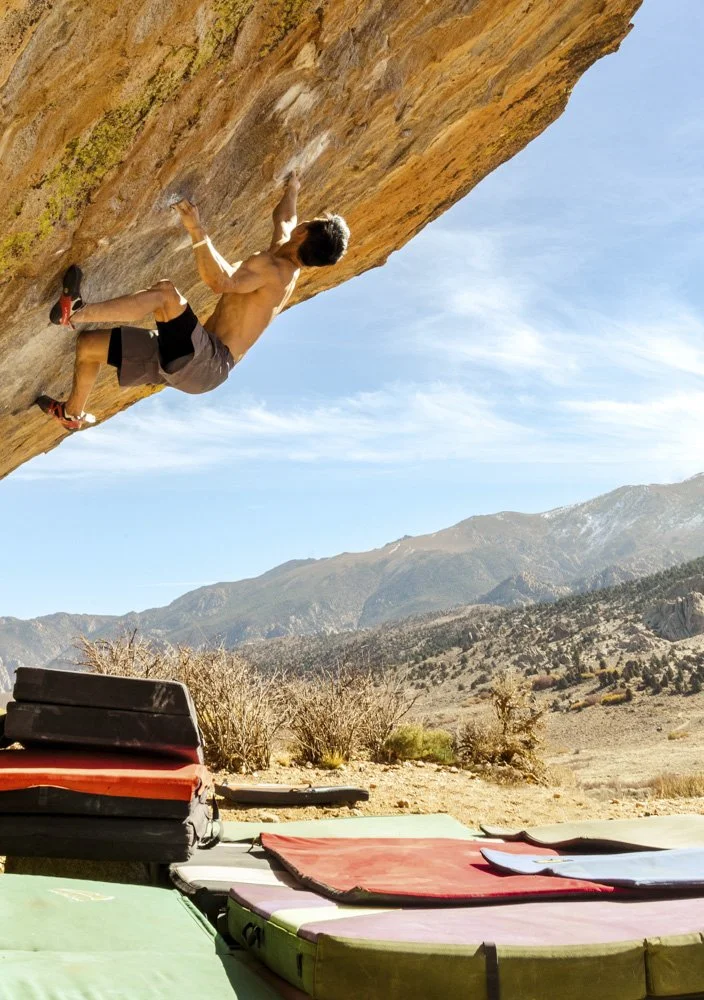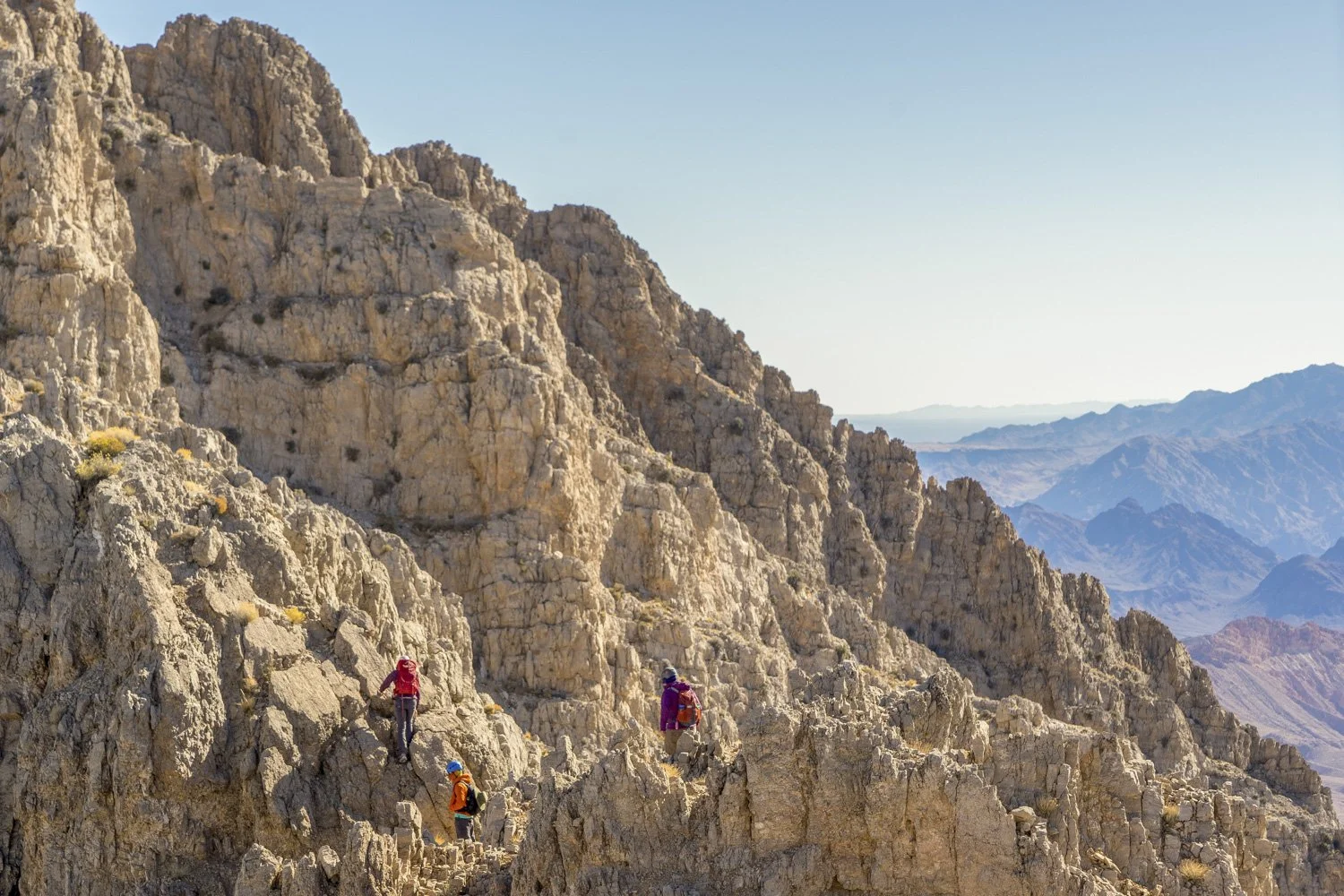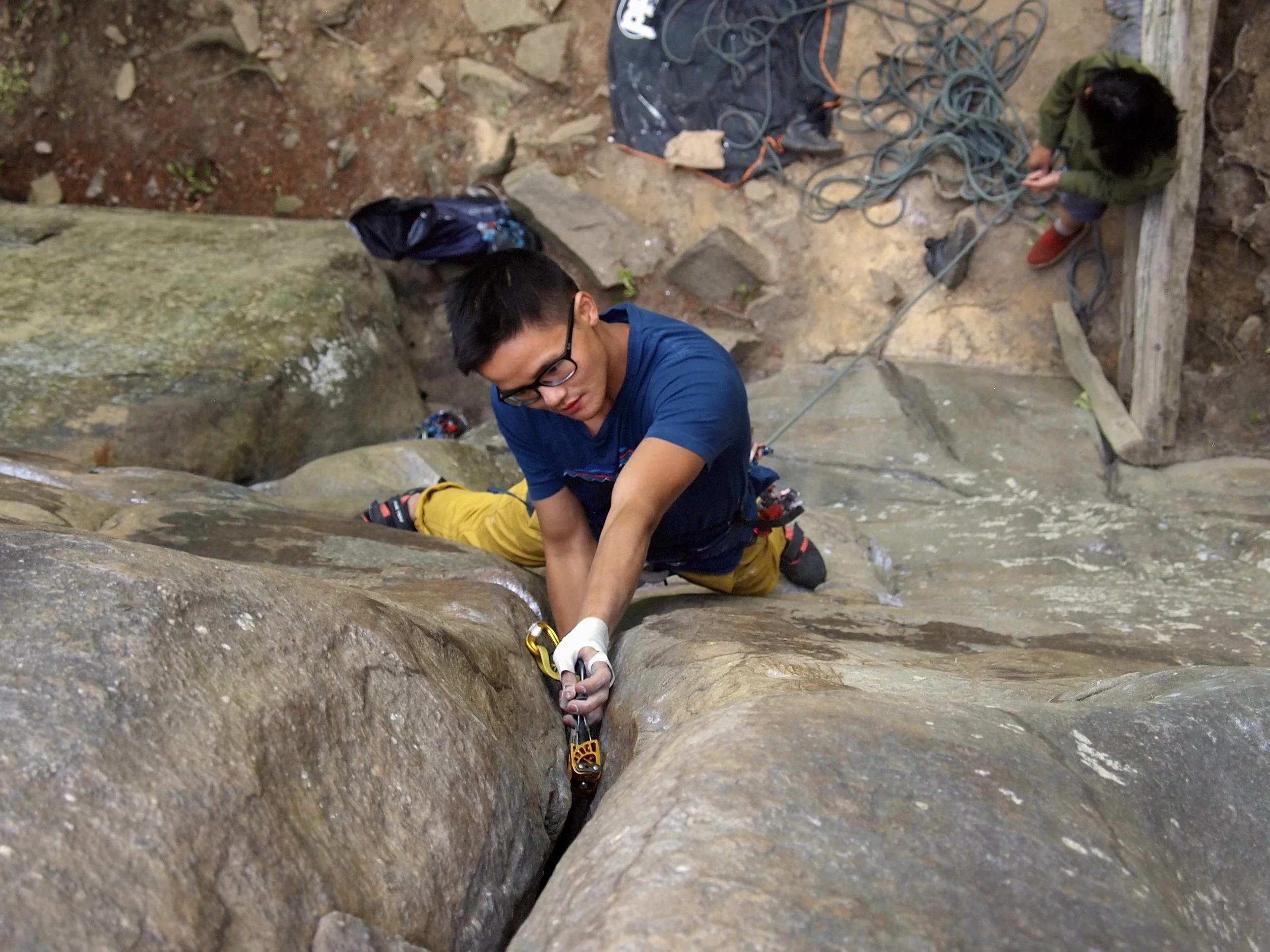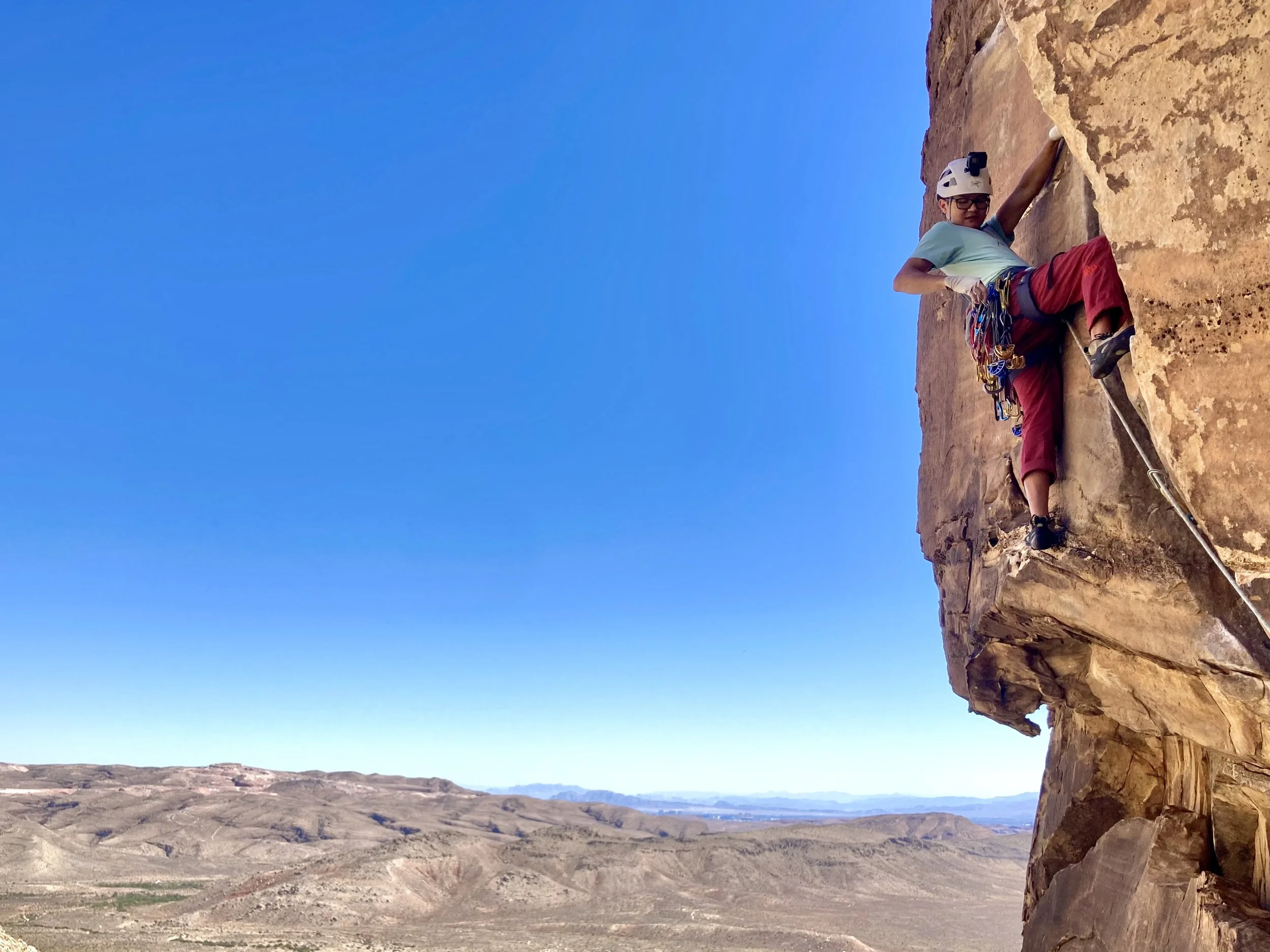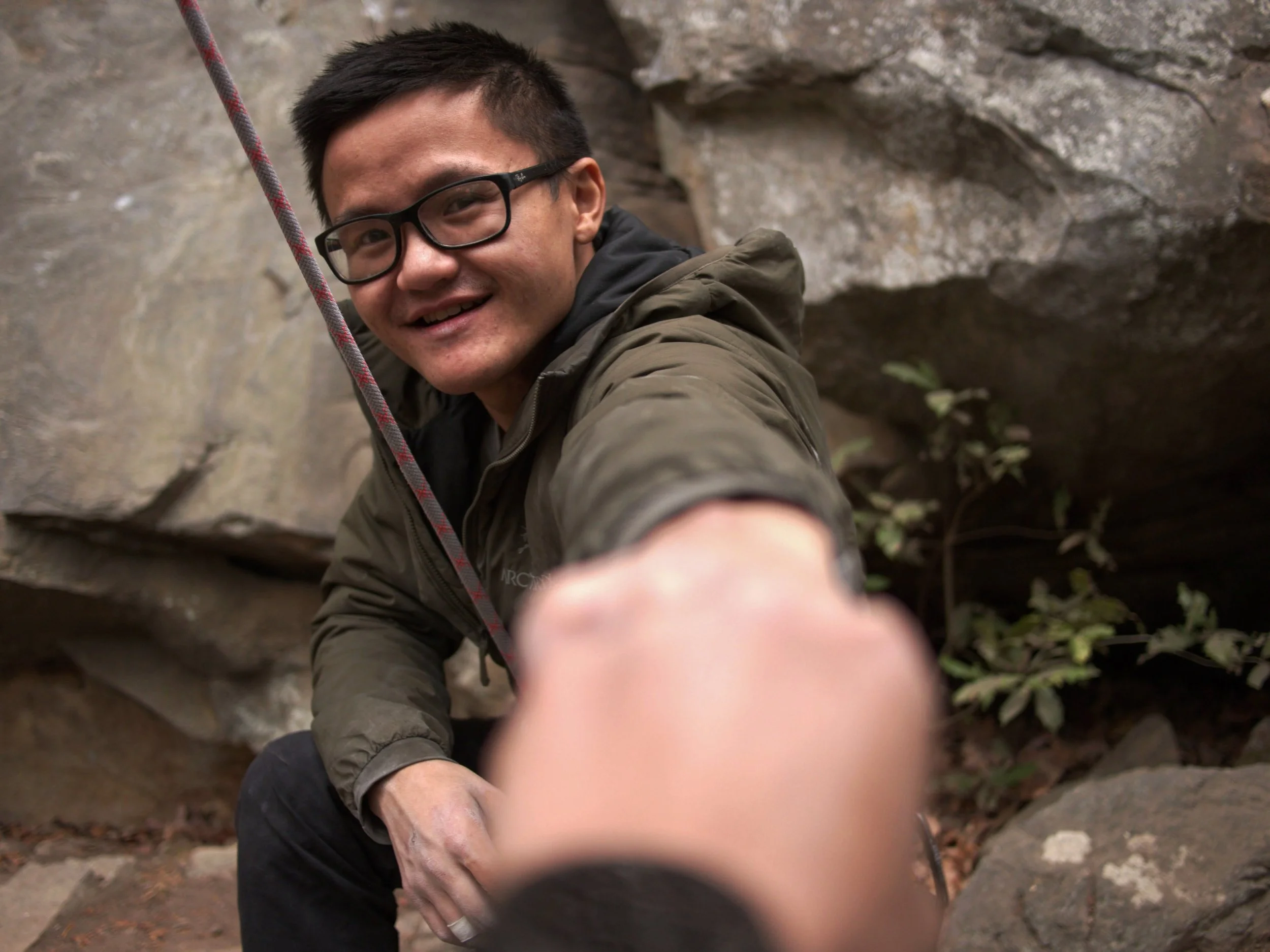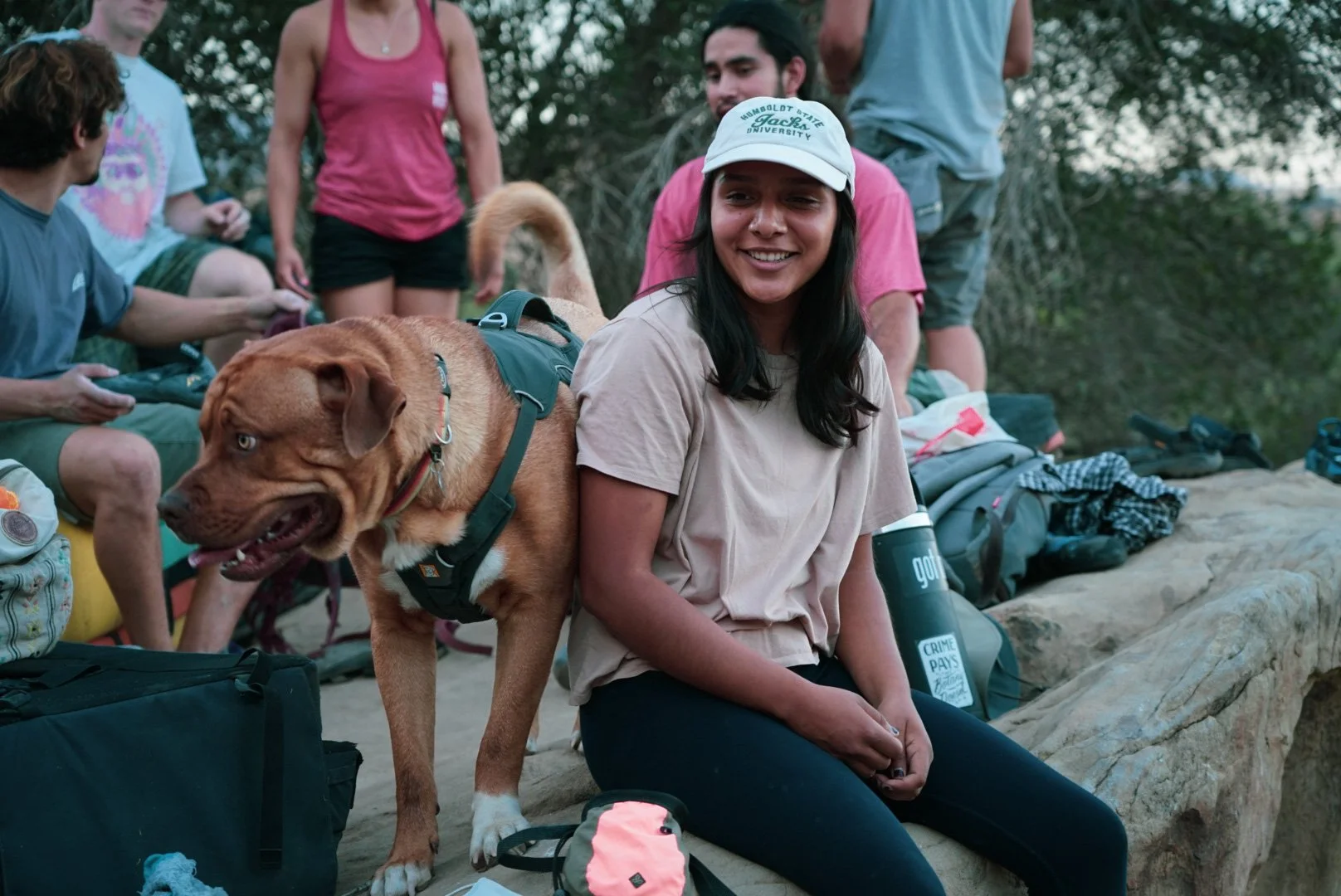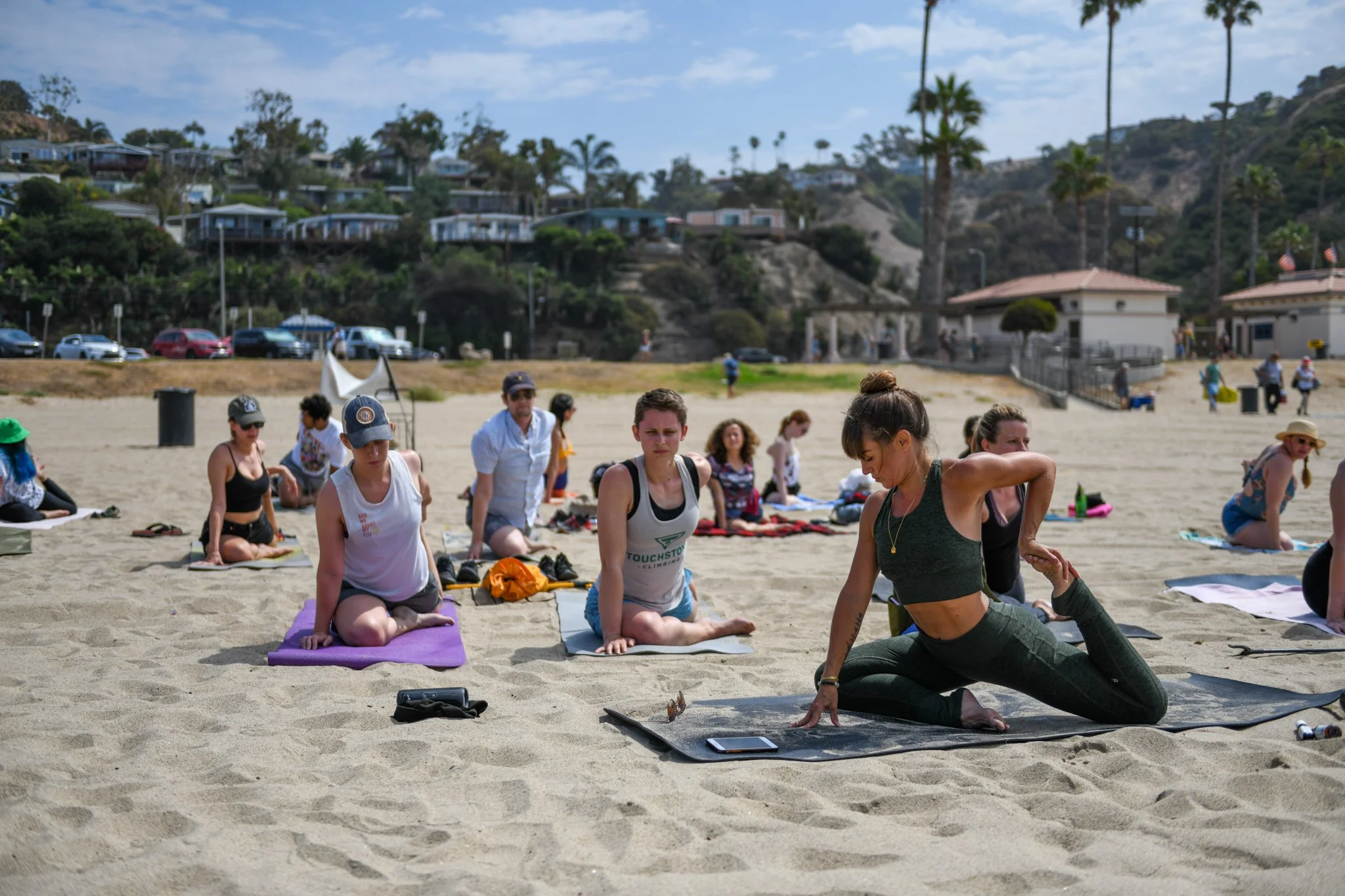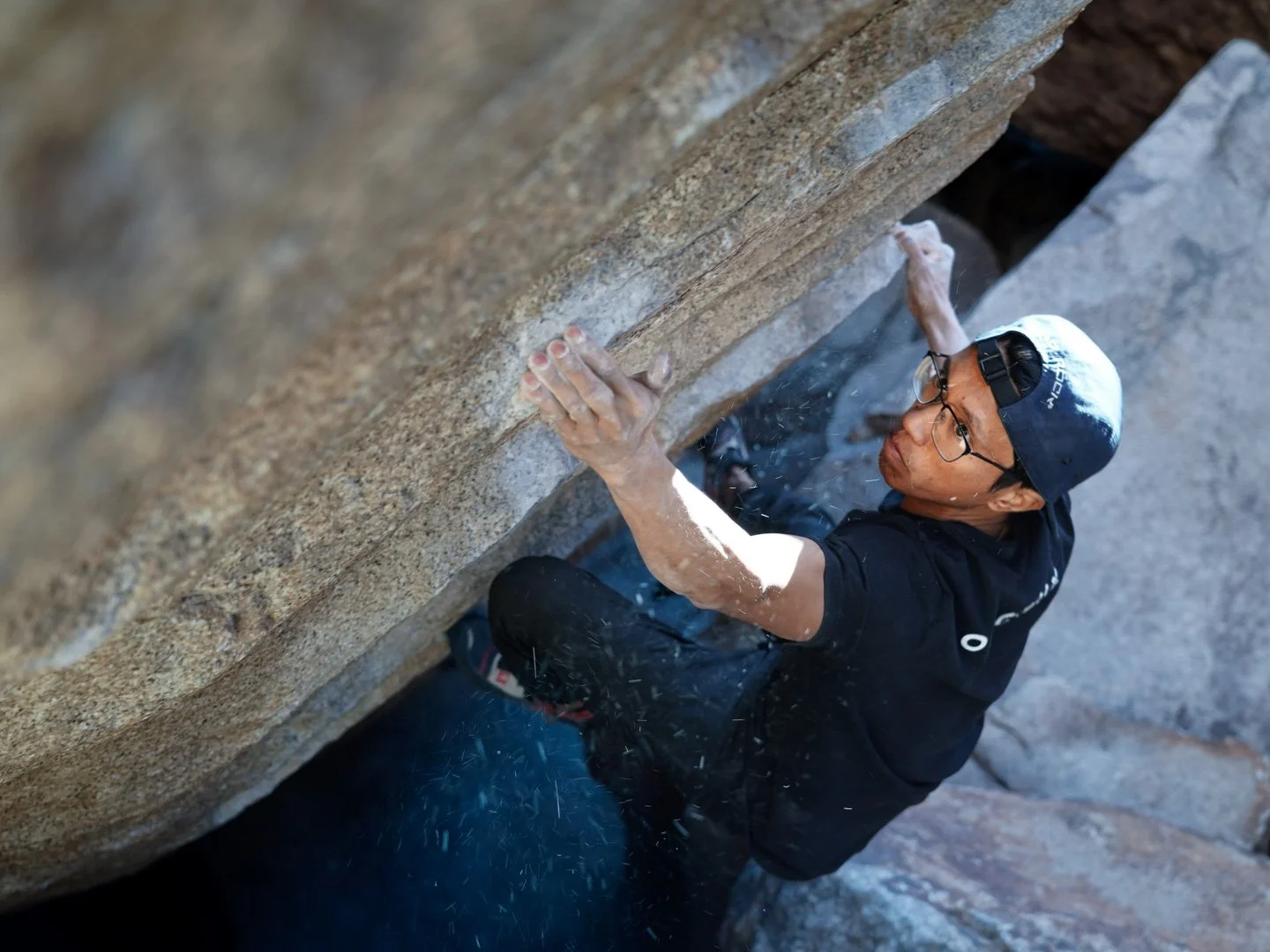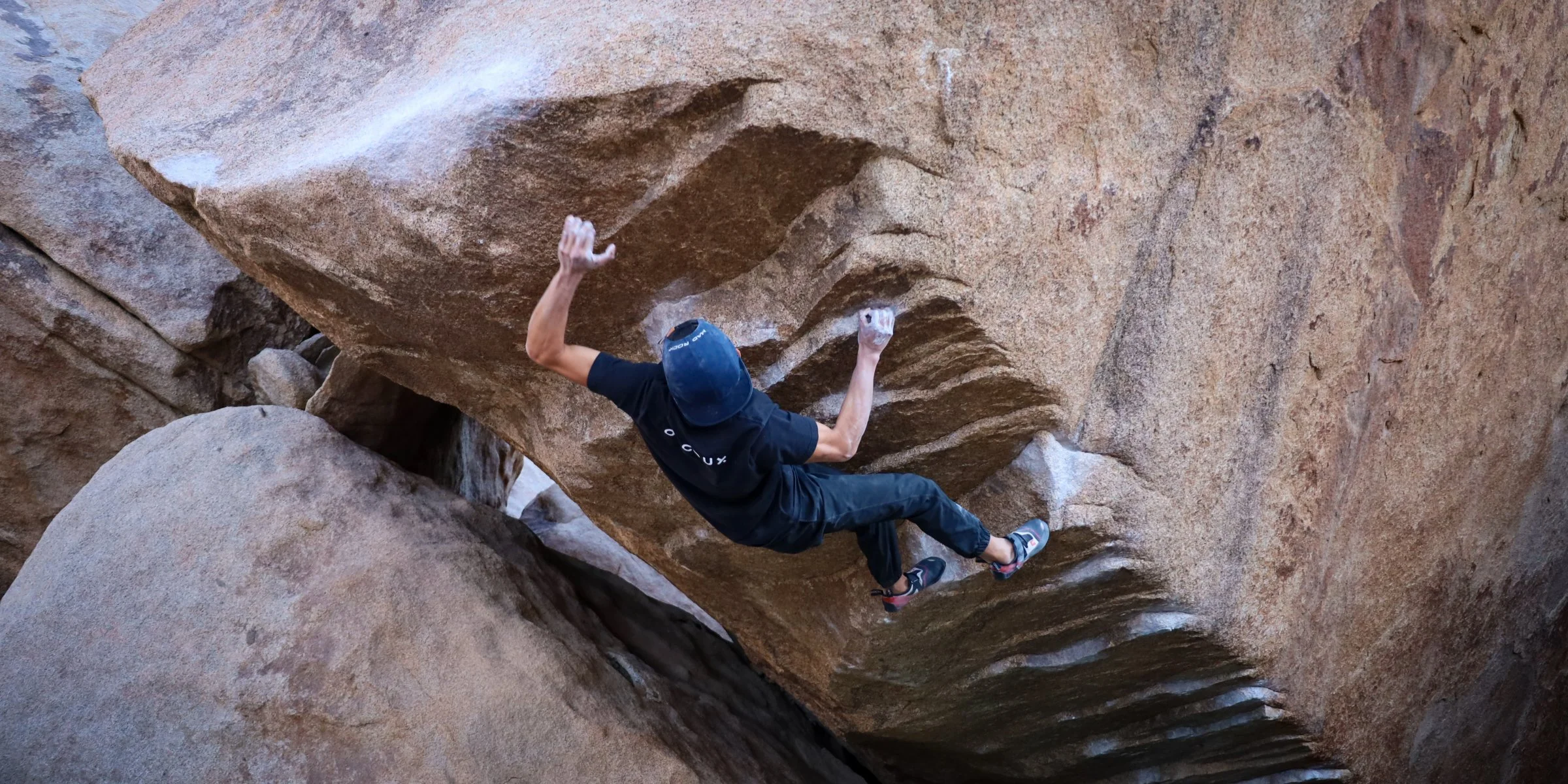Asian American Voices: Katherine Ku
An author’s note reflecting on the last three conversations and her own life, in honor of AAPI Heritage Month.
It’s been a while since I published the last installment of the Asian American Voices series, but let’s just pretend I was saving this for Asian American Heritage Month on purpose (definitely not procrastinating). Regardless, I’ve finally been able to reflect on these conversations as a whole and why I even really wanted to do write about this in the first place.
When you walk into a climbing gym or go out to the crag, you’re likely to meet people of all ages and careers - nurses, bankers, real estate agents, geologists, teachers… the list goes on. Yes, ethnic diversity in our sport has improved, especially when you compare a modern pool of rock climbers to the stereotypical long-haired, mustached, acid-taking, and overwhelmingly white trad climbers of the 60s and 70s. This isn’t to say that the legendary Stonemasters were not integral to the development of climbing - their contributions were tremendous, but the future of rock climbing still stands to gain much more from cultural diversity.
As an Asian American creator and climber, I looked up to Jimmy Chin as a filmmaker. When I started watching comp climbing, I found myself rooting for Asian / AAPI climbers like Quinn Mason and Akiyo Noguchi.
I remembered reading about another climber, Angela Lee’s story in the Climbing Zine. Her article, Parallel Traditions hit me hard. Instead of becoming a lawyer after law school, Angela instead chose to climb and work as a homestead farmer, where she “found happiness… reconnecting with nature.” Her longing to make peace with her Korean culture, friction with her parents, and dedication to rock climbing seemed all too familiar.
When I came across her article, I was working full-time as a management consultant and could barely believe what I was reading. While I was often miserable and working remotely 50-60 hour weeks, I could scarcely imagine an alternative at the time.
I had worked hard to secure my job before I had even graduated college. When I received my offer letter, I had let out a sigh of relief - my years of schooling had paid off and I’d be, in my mind, set for life. I’d be financially independent, living the young professional life, and my parents would be proud of me.
I thought I was ready for the lack of work life balance, reminding myself it was necessary and that I was lucky to even have a job in the wake of the pandemic. I had told myself I would stick it out for two years. Only then I would try something new. After putting my degree to good use, after saving up for a few years.
But instead, I found myself anxious, constantly checking my laptop and work phone, scrambling to complete tasks I often thought to be unreasonably time-consuming. While I sunk into the corporate lifestyle, my love for climbing grew. I began working through meal breaks, desperate to get off work early enough to rush to the gym for a late night bouldering session.
Soon after, I began shooting climbing photography, taking my camera wherever I could. I began daydreaming about climbing as much as I wanted, taking photos for a living. I thought about Jimmy Chin, who moved into his car after graduation to become a fulltime dirtbag, despite his parents’ objections. And then there was Angela, who had faced similar cultural challenges and expectations. They had made it.
So why couldn’t I?
To me, there were a thousand reasons why not. Among the top: 1) I didn’t even go to art school so how could I compete? 2) I wasn’t a strong climber. 3) I just wasn’t good enough. And what would my family think? Just the thought of telling my mother that I wanted to pursue a career in climbing media made me sick. (To my credit, I was right to be nervous about this.)
It took me a year to decide to take a leave from my job to give working in the climbing industry a try. It took me three additional months to actually quit, finally removing myself from the simultaneously comforting and mortifying possibility of returning to my steady consulting job.
During this entire time, I recognized that by allowing me to stay under her roof, my mother was expressing her reluctant support. She was doing what she could, providing shelter for me - no matter how much we argued or fought about my career decisions.
But between yelling matches and slammed doors, I couldn’t understand why she couldn’t understand me. She asked me why I’d leave my office job for a physically demanding and unstable career. After all, my parents had worked hard so that I could avoid this struggle, yet I chose to spend long days hiking and hauling gear up mountains, often returning home covered in dirt and chalk.
I knew, like any parents, they just wanted the best for their child, but it drove me crazy that they couldn’t understand why I wanted to chase my passions. Even when I started to see their point of view, I just wished for an easier way out. It scared me to think that no matter what I did, I’d never make my parents as proud as when I had graduated from business school and gotten my consulting job.
Almost any young Asian American knows that the pressure to succeed is pretty much just a part of life. At times it feels overwhelming to fight these cultural constraints while struggling to achieve professional and social success.
To say the least, the AAPI climbing community has brought me a sense of empathy that I desperately needed. Being able to interview others granted me insight into each of our different stories, and I also saw the similarities among us. It made me proud of my heritage; I’m lucky to have family members that would never keep their noses out of my business, regardless of how far I push our limits.
For the record, I still haven’t “made it.” And I still feel the need to prove to myself, my family, and my peers that I can. But hopefully, I’m on my way, and in the meantime, I’ll try to be patient and empathetic.
Asian American Voices: Jason Quan
He says that “from his years of going outside, I don’t see as much diversity as I’d like.” As a result, he’s taken matters into his own hands, working with organizations such Climb the Gap, and the Queer Climbing Collective.
Adventure Photographer and Content Creator
by Katherine Ku and Matt Levy
Jason’s story is the third in the Asian American voices series. He is a Southern California based rock climber and photographer who often collaborates with affinity groups to promote diversity and inclusivity in our sport.
Jason started off as an internet friend I met on Facebook, but pretty soon after exchanging our first messages, we decided to meet up to climb together. (Because meeting up with strangers from the internet is something that's ok to do now right?) Anyway, I remember thinking that he must be a natural mentor, because soon after, I trusted him enough to teach me how to rappel off the edge of Corpse Wall. A few months after that, he taught me to trad climb in Ojai, pointing out the flaws in my placements and teaching me how to make my own tape crack gloves. A few months after that, we solo’d Tenaya Peak’s Northwest Buttress with another friend.
Jason is someone who chases sunrises and is actually on time (or even early) for alpine starts. He loves a good hex placement and aesthetic routes with a good view all the way up. He’s also the one of the only other Asian American adventure content creators I actually know. When we think of acclaimed Asian American adventure filmmakers and photographers, names like Jimmy Chin, Irene Yee (aka Lady Lockoff), and Matty Hong come to mind. Jason, though, is on a journey as a content creator, navigating a world that loves adventure media and an increasingly saturated media landscape.
Funny enough, Jason told me he actually started getting into outdoor sports to impress a girl who wanted to go snow camping. That relationship didn’t last, but his love for the outdoors did. He became an avid mountaineer and, eventually, a rock climber when his brother needed a belay partner about five years ago. His interest in photography bloomed even earlier, as he started capturing and sharing images from his travels.
Since then, climbing has become his way of detoxing mentally and the outdoor space has become a setting for him to both “think for himself and connect with other people.” And he’s definitely been successful at connecting with others.
Jason has come a long way from just teaching gumbies (like myself) how not to hurt themselves outside. He admits that he is “naturally inclined to mentorship,” and stresses the importance of promoting diversity in both rock climbing and photography. Currently, he is one of six mentees in Climbing for All, a program for BIPOC climbing photographers jointly hosted by Climbing Magazine and Adidas. As part of this program, he is working closely with Irene Yee, an adventure photographer and champion for women, BIPOC athletes, and LGBTQ communities.
It’s no secret to Jason that as residents of Southern California, we live in a bubble with higher than average levels of diversity. He says that “from his years of going outside, I don’t see as much diversity as I’d like.” As a result, he’s taken matters into his own hands, working with organizations such Climb the Gap, and the Queer Climbing Collective. And he doesn’t want to stop here - he wants to keep connecting with people like him and aims to become a National Geographic photographer, which he sees as the gold standard of photography.
For now, he wants to continue to help people “mesh together” and bring together people with similar goals. Jason gains a “greater sense of fulfillment…helping someone else achieve their goals,” rather than directly getting something out of it for himself. He also continues to face a struggle modern content creators know all too well - self-promoting from the ground up and continuing to learn as media trends and consumer demands rapidly evolve.
Check out some of Jason’s work in the gallery below. To keep up with him and support him, follow him on Instagram and visit his online portfolio!



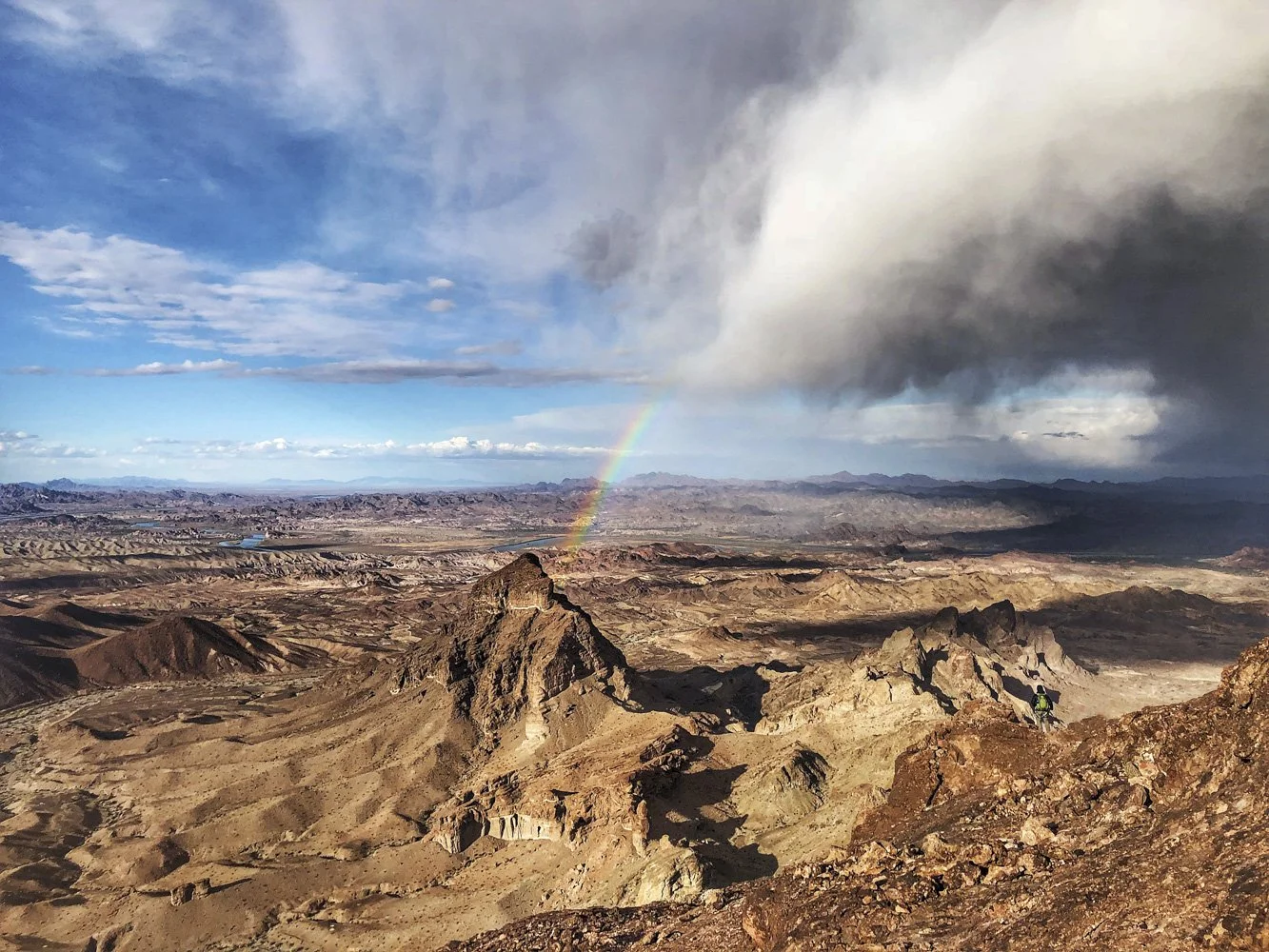








Asian American Voices: Robby Ondevilla
For Robby, it’s been “rewarding to see that people are so willing to reach out when they’re traveling,” to connect with SAC locals in a given area. “It’s important to have diversity among the rock climbing community, treat each other with the utmost respect, and lift each other up.”
Physical Therapist & Subtle Asian Climbing Administrator
by Katherine Ku and Matt Levy
Robby’s story is the second in the Asian American voices series. He, along with the Subtle Asian Climbing team, are pushing to increase diversity in rock climbing by growing an online community and by connecting AAPI climbers all over the world.
Subtle Asian Climbing started out as an offshoot of Subtle Asian Traits (SAT), a Facebook Group founded in September of 2018 that rapidly grew to become one of the largest online Asian communities in the world. SAT, a sort of embodiment of the Asian experience in the West, now has around 2 million members, and is a phenomenon that has been covered by the likes of the New York Times.
As an Asian American, I’m a member of SAT as well as a number of its subgroups, such as Subtle Asian Dating (SAD) and Subtle Asian Cooking. At first glance, these groups are just filled with lighthearted, even silly, content such as memes and everyday anecdotes. However, you’ll quickly realize these posts are extremely relatable and incredibly good at succinctly describing specific experiences of hundreds of thousands of people.
Subtle Asian Climbing (SAC) also serves this purpose, bringing together Asian rock climbers from all over the world via memes and posts highlighting members of the community. I remember watching members participate in the #dynochallenge when i first joined, scrolling through posts of people catching holds from crazy jumps. Today, SAC is over 4,600 members strong, and has grown beyond an online presence into the real world, hosting in-person meet-ups both in gyms and outdoors.
To better understand the growth behind SAC, I sat down with my friend Robby Ondevilla, who is currently an admin on the SAC Facebook page and manages the SAC Instagram account. Robby is also a rock climber of 2.5 years and physical therapist based out of New Jersey. He is thoughtful and well-spoken, considering each of my questions carefully before answering.
Robby’s climbing career started when his brother approached him with a 2-for-1 special at New Jersey Rock Gym. Like me, he was a member of several Subtle Asian groups, including SAC, where he “lurked around for a little bit,” eventually posting more frequently, looking for advice as a newer climber. His role in SAC also grew when he made a suggestion to start an Instagram page to accompany the Facebook group, and was subsequently enlisted to create and run the account.
What started out as a mere spin-off of a larger trend, has since evolved into something much more. SAC has become almost an independent affinity group, a “safe space for a lot of us with the same values.” Especially during the height of the pandemic, it became clear that the value of SAC lies in its ability to bring together individuals who are not only passionate about rock climbing, but have also had similar experiences along the way. Robby himself has encountered some uncomfortable situations as an Asian American climber. He finds himself hesitant to visit nearby crags like Haycock Mountain in Pennsylvania, as “it isn’t the most diverse area.” Other times, he finds that his “choice of place to go climb and hike” are influenced by the possibility of being the only POC, especially in rural areas where there may be safety concerns. As a BIPOC climber, it’s easy to question whether this unease is all mental, but Robby is pushing for SAC to play a larger role in validating and addressing concerns regarding diversity and safety in the outdoors.
Furthermore, Robby and the rest of the SAC team have been instrumental in helping people meet both digitally and physically. While they continue to work to create more clear cut guidelines for planning and coordinating meetups, SAC has successfully hosted meetups all over the country, from Brooklyn Boulders in NYC to Red Rock in Las Vegas. For Robby, it’s been “rewarding to see that people are so willing to reach out when they’re traveling,” to connect with SAC locals in a given area. “It’s important to have diversity among the rock climbing community, treat each other with the utmost respect, and lift each other up.”
It’s clear that Robby has played a huge role in making the SAC community the safe space it is today, as he describes how much he loves watching people connect and create lasting bonds. Many of the current SAC leaders may not work full time in the rock climbing industry, yet the future of the group is full of potential. Robby confesses it’s “hard at times to keep up with how fast SAC is growing,” but “loves how it is currently thriving.” Despite his mellow composure, Robby speaks with certainty when he expresses his excitement for SAC’s future and that he and the core team “will give it all they got.”
Asian American Voices: John Nguyen
John is a trailblazer in his own right. To him, his voice is small, and it took him a long time to realize that he was even a leader. But really, he’s forging a path for more to follow after him.
Youth Climbing Coach & AMGA-Certified Single Pitch Instructor, SCARPA Athlete Mentorship Initiative Mentee
by Katherine Ku and Matt Levy
Photos by John Nguyen, Milana Ortega, Tiffany Dang, and Katherine Ku
John’s story is the first of a series of Asian American voices in the climbing world that I wanted to understand and publish. As a member of the AAPI climbing community, I’ve met several people along the way who have changed my journey and what I thought I was capable of. There is more to be understood, and I hope that through these weekly articles, these voices are at least heard by a few more people than they would have otherwise.
I first connected with John Nguyen when he asked me for a “Vote the Outdoors” sticker and I, in turn, asked to borrow his Petzl pro-deal. Though I proceeded to lose his pro-deal, we quickly became close friends and I met him in person for the first time when I crashed at his house and multi-pitched with him when I passed through Virginia on a cross-country road trip.
John is young and addicted to Coca-Cola. He loves wearing bright colors at the gym and crag. He knows he swears too much, but does it anyway. He loves every piece of gear he owns as if it was his child. John is a lot of things, but he was definitely born to climb.
After watching Free Solo back in 2019 and then living out of a car during his first climbing trip in Utah, John fell in love and dedicated his whole life to rock climbing. Today, he’s an experienced boulderer and sport climber, aiming to climb 8a in both disciplines. He inexplicably loves crack climbing and is the proud owner of a triple rack. He coaches the youth comp team at Sportrock Climbing Center in Virginia and is an AMGA-certified Single Pitch Instructor.
For John, climbing has been about learning, teaching, and growth. He began rock climbing at a low point in his life, as just a way to exercise, but later giving him a way to “put himself in a better spot and climb out of a hole he dug for himself.” Still, he didn’t expect to become a community leader and representative for others like him at the time.
Within a year of starting to climb, he began learning about affinity groups like Subtle Asian Climbing on social media. When asked about his role in the community, he said he felt that “climbing was fairly selfish” and that he wanted to change that. To him, “there’s a lot more to it than climbing up a route.” He offered support and strengthened the foundations of a community that had built him up, the community that granted him the confidence to want more.
Though climbing is a sport that is trying to become more inclusive and diverse, it still has a long way to go. While indoor climbing is becoming more popular across the board, at least in his locale, John is often the only BIPOC climber present at the crag. After earning his SPI certification, John also excitedly posted in the Subtle Asian Climbing (SAC) facebook group (which is 4,600 members strong by the way), hoping to connect with other AAPI climbing guides. To his disappointment, his post was met with radio silence.
This, unfortunately, doesn’t really come as a complete surprise. When John decided to pursue a career in the climbing and outdoor industry, he dropped everything, including finishing up his bachelor’s degree. He spoke honestly to me, said he struggled when he started out and is still struggling, admitting that he continues to be “unsure of a lot of things.” It’s difficult to navigate the outdoor industry, which isn’t exactly known to be teeming with high-paying opportunities, especially with parents who don’t fully approve of his career choices. They push him to find a “real” job, but he is now “focusing more on happiness than stability.” John has been told repeatedly that he can’t live his dream, or even to find new dreams. These things continue to cause him anxiety, but he says he’s “pushing through it slowly but surely.” He told me that it “hasn’t destroyed him” yet and that “things are slowly falling into his lap.”
Rock climbing has caused cultural friction for John, but has also motivated him to “rekindle a connection with his culture.” He’s working on embracing his role as community leader. After earning a spot as a mentee in Scarpa’s Athlete Mentorship Initiative, John hosted an affinity meet-up with SAC as his Scarpa Capstone project. He aims to continue to introduce BIPOC climbers to the outdoors through education, eventually hoping to run clinics and create education videos on crag etiquette, safety, and more.
John is a trailblazer in his own right. To him, his voice is small, and it took him a long time to realize that he was even a leader. But really, he’s forging a path for more to follow after him. Though he proudly claims that his comp kids love him, he’s still surprised every time someone tells him that he’s made a positive impact on their life, whether it’s something as small as teaching them how to build an anchor or even inspiring them to pursue a career in the climbing industry. As someone who never thought he’d climb v5, he’s making a hell of an impact, and his voice is only getting louder.





Community Leader: Kristen Hernandez
Kristen aims to “build communities within communities,” while “inspiring and motivating [people] to care more about the places they climb and hike.” To her, it’s simple - “it’s about respecting the land you walk on.”
Climber, Advocate, and founder of Trailmothers
by Katherine Ku and Matt Levy
At first glance, Stoney Point Park is trashy, unkempt, and not at all impressive. The mild, yet impossible to ignore smell of horse manure wafts into your nostrils. The sandstone boulders are marred by graffiti, and there is broken glass scattered all over the sand. If you’re lucky, you might even see pieces of a car bumper scattered around the perimeter of the park or an abandoned shopping cart peeking out from the dry shrubbery.
Despite all this, for many SoCal climbers (including myself), Stoney represents their first outdoor climbing experience. It’s a crag loaded with history, with lines established by the likes of Royal Robbins, Yvon Chouinard, and John Bachar. Seeing the park in its current conditions is disappointing, to say the least.
Enter Kristen Hernandez, Stoney’s guardian angel in many ways. You’ll see her, often accompanied by her son Liam and a crew of volunteer stewards, working day in and day out, picking up literal tons of trash, sifting pieces of glass out of the sand, washing spray paint from the rock, and even rebolting top rope and sport lines.
I met her for the first time at a Stoney Point clean-up, hosted by Trailmothers, an organization she founded, dedicated to protecting and preserving the outdoors. I watched as she handed out large blue buckets, garbage bags, trash pickers, and other materials we’d need throughout the day. She encouraged us to stay hydrated, reminded us to eat snacks, and cheered us on as we wriggled through brambles to pick up left behind beer bottles. We picked up over 200 pounds of trash that day.
So how did this all start? According to Kristen, it began when she became pregnant with her son in 2012. Instead of giving up her love for the outdoors, she brought her son along as he grew - hiking through Los Feliz Park in Burbank, picking up trash and learning about the trails as she went. She started Trailmothers as she wondered whether there were “other mothers like her,” but today, volunteers of the organization are from “all walks of life.” She’s hosted dozens of events, from “clean and climb” days at Stoney and Malibu Creek to yoga and clean-ups at the beach. Kristen aims to “build communities within communities,” while “inspiring and motivating [people] to care more about the places they climb and hike.” To her, it’s simple - “it’s about respecting the land you walk on.”
Kristen’s motivation is contagious, not only as a community leader, but also as a rock climber. She recounted to me an experience from years ago that held her back from climbing, when some “told [her] that [she] had to be physically strong and had to look a certain way to climb.” Today, climbing is a means for her to recharge herself, something that brings her “immense joy, allows her to be herself no matter what, and something that helped her gain confidence within herself.” Her passion is evident, as she proudly admits that climbing is a vital part of her life, helping her stay balanced and driven.
Today, she is working to grow Trailmothers through partnerships with other like-minded organizations like We Explore Earth and Overdue to co-host larger events in the upcoming year. She also hopes to work with local climbing gyms to educate rock climbers of all levels on environmental ethics before they head outdoors. Most of all, she urges us to all do our part, as she continues to educate and lead the community in the cause for environmental conservation. Meeting Kristen has been a bigger motivator than I realized - I’m reminded of that first clean-up I attended every time I see the big bucket I still take outside to collect trash I see at the crag.
If you’re interested in learning more or helping out, Trailmothers is hosting a Stoney Point Park Clean & Climb event in honor of Earth Month on 4/9/22 from 10am - 12pm. In partnership with We Explore Earth, Trailmothers will be co-hosting beginner backpacking / camping events. Kristen and her crew will also be co-hosting more beach clean-ups and education activities with Overdue in the near future.
Trailmothers is always looking for more environmental stewards and new initiatives focused on outdoor preservation and restoration. For more updated news and events from Trailmothers, please also follow them on Instagram @trailmothers.la and check out their website.







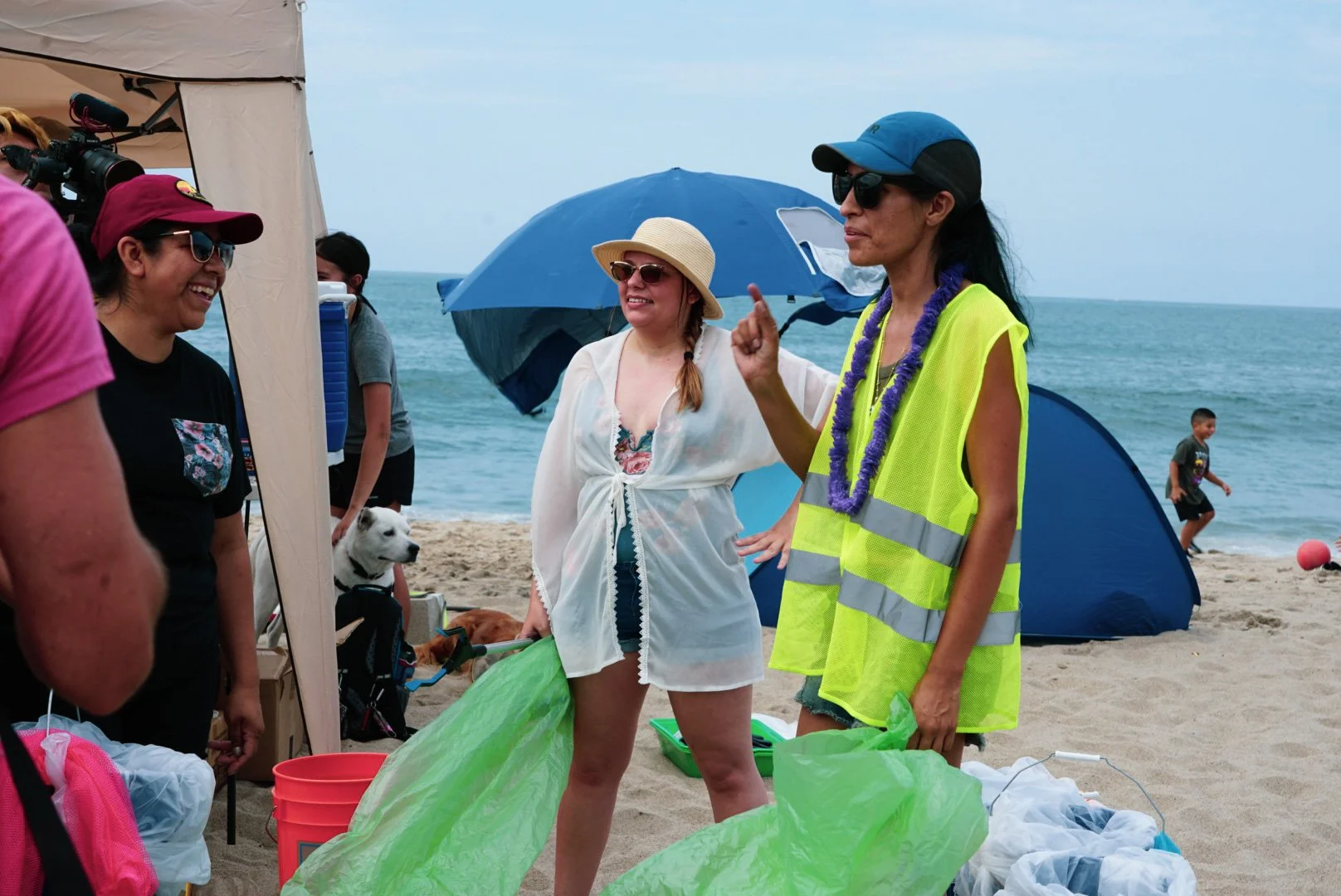

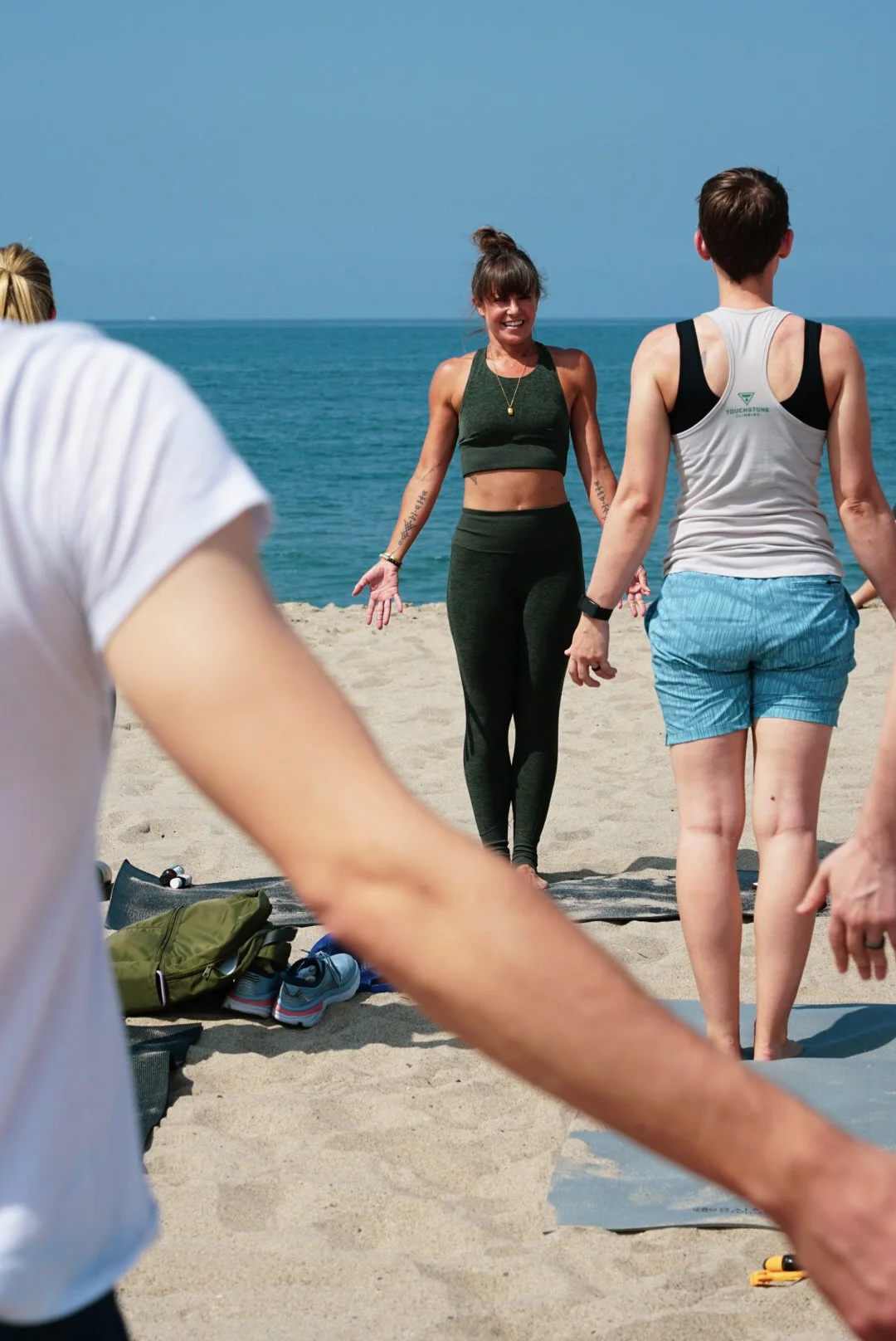
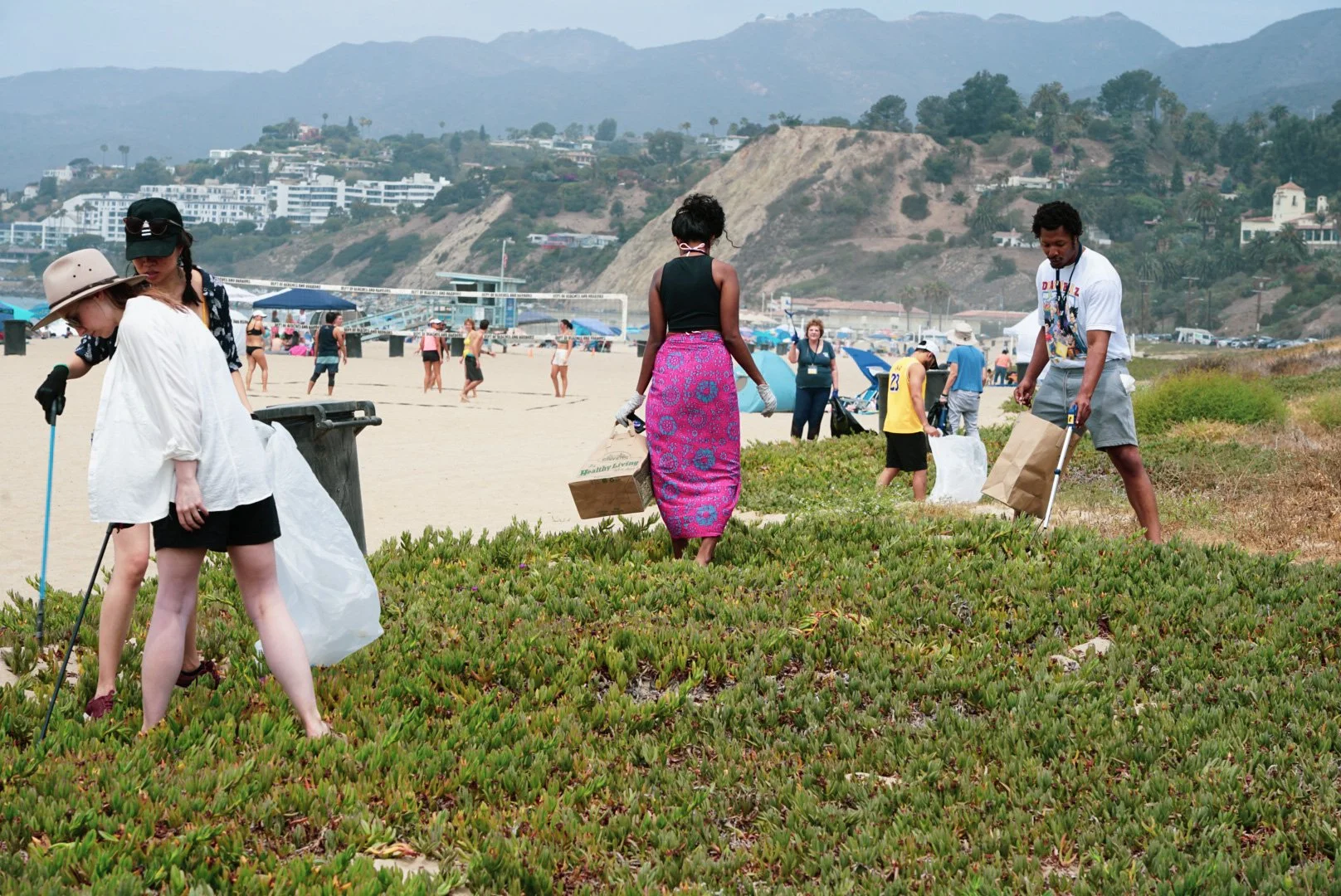






Rail Shark: The soon-to-be classic of elite Joshua Tree bouldering
So who or what is a Rail Shark? If you ask FA Jeremy Schoenborn, the answer is quite simple. Rail Shark is a soon-to-be classic bloc that is “second to none in Joshua Tree.”
by Matt Levy and Katherine Ku
If you’re a regular consumer of climbing media, you may have heard an interesting problem name pop up more and more frequently in the last few months: Rail Shark.
So who or what is a Rail Shark? If you ask FA Jeremy Schoenborn, the answer is quite simple. Rail Shark is a soon-to-be classic bloc that is “second to none in Joshua Tree.”
Schoenborn immediately saw potential in the overhanging face with blocky rails lining the underside, saying it was “certainly climbable” but that he “seriously doubted it was any easier than V14.” So Schoenborn got to work cleaning and projecting. By the end of last year's winter season, Schoenborn had snagged the FA, setting the stage for a second ascent by Joe Maier, a third by Jordan Mathew, and a fourth by none other than Ethan Pringle, who famously flashed the “ultra-classic Moonlight Buttress.” Jeremy Schoenborn is not the only boulderer on the Joshua Tree circuit to give high praise to Rail Shark.
Despite the unseasonably warm weather in December and hardly adequate crashpad coverage, Mathew was able to put down the boulder on his first Joshua Tree trip of the season. He was impressed by the bloc, saying that Rail Shark had “everything [he] looks for in a rock climb”— “committing,” “proud,” and “full-value from start to finish, all the way to the mantle.” It’s not everyday you run into a boulder that earns its full five stars in both movement and aesthetics.
Just before Christmas, Pringle hiked out to Rail Shark with his crew and found that the boulder wouldn’t go down as easily as he hoped. After figuring out the tricky crux sequence and a battle with sweaty hands, he was surprised to finish off the boulder with “one hail-mary effort from the sit start.” Pringle, too, praised Rail Shark, calling it an “epic find” and “as mega as they come.” In our conversation with him, he confirmed that it was a “true standout,” calling Schoenborn’s discovery a “world class-contribution.”
My team and I drove out to the desert, cameras and crag snacks in tow. We weaved our way through the talus field and squeezed bodies and pads through little tunnels in the formation, moving upward to find this new boulder everybody was talking about. Before long, we all had the same question— how the hell did Jeremy find this thing?
To hear Schoenborn tell it, he had been at the top of the famous sport line “New World Order” when he looked down into the talus field and saw several boulders he wanted to check up on. “One boulder led to the next and the Rail Shark appeared as soon as I turned the right corner.” And it’s true. As one approaches the Shark, every other formation falls away and leaves you staring, entranced, into Rail Shark’s great, dark maw. Mercene described his first time finding the Shark, saying “It’s rad when you come out of the talus and The Shark appears. It was like back in the day when you play Pokémon on your Gameboy and the rare Pokémon finally comes up.”
But just how rare a creature is Rail Shark?
Joshua Tree is among the most heavily trafficked bouldering spots in Southern California, and more often than not you’ll find droves of climbers gathered around classic lines put up starting in the 60s. Though there are over 1,200 established and recorded problems, climbers like Mathew see Rail Shark as a reminder of the “vast potential” of Joshua Tree. Five-stars lines are still out there - “you just have to be willing to hunt for them.” Just take a cue from Jeremy Schoenborn, who knows that even in our very own roarin’ ‘20s, the next area classic could be just an adventurous scramble away.


